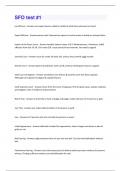Assignment 1 2024
Unique #:618791
Due Date: 15 May 2024
This document includes:
• Helpful answers and guidelines
• Detailed explanations and/ or calculations
• References
Connect with the tutor on
+27 68 812 0934
,© Study Shack 2024. All rights Reserved +27 68 812 0934
, QUESTION 1.1 (2 ANSWERS PROVIDED)
Work-related stress is influenced by various factors that interact with individual
characteristics and job demands. Three key factors can contribute to work
stress in organizations:
1. Job Demands: Excessive workloads, tight deadlines, and high levels of
responsibility without adequate resources or control can significantly
increase stress levels. For example, an employee might experience
chronic stress due to an overwhelming number of tasks and the
pressure to meet unrealistic deadlines, often leading to burnout and
reduced productivity (Bakker & Demerouti, 2017).
2. Work-Life Balance: Difficulty in balancing job demands with family and
personal responsibilities can lead to stress. If an individual, such as the
person in the story provided, spends too much time thinking about
work or bringing work home, this can affect their relationships and
personal well-being, contributing to increased stress levels (Greenhaus
& Beutell, 2020).
3. Support Systems: Lack of support from colleagues and management
can exacerbate stress at work. When employees do not feel
supported, they may find it more difficult to cope with job demands and
may experience a sense of isolation or unfair treatment. An absence of
feedback, acknowledgment, or assistance from a supervisor or peers
can leave an employee feeling undervalued and overburdened,
contributing to their stress (Kim & Beehr, 2020).
These factors often combine and interact to create a stressful working
environment. The stress can manifest in physical symptoms (e.g., palpitations
mentioned in the story), cognitive effects (difficulty focusing, constant worry),
emotional responses (withdrawal, anxiety), and behavioral changes (reduced
social interactions). Understanding these factors can help organizations design
better workplace interventions to reduce stress and improve the overall well-
being of their employees.
OR
Some key factors that contribute to work stress in organizations include heavy
workloads, lack of control over work, poor communication, and conflicts with
colleagues or management (Nieuwenhuijsen, Bruinvels, & Frings-Dresen,
2010). For example, an employee who is constantly given more tasks than they
© Study Shack 2024. All rights Reserved +27 68 812 0934






